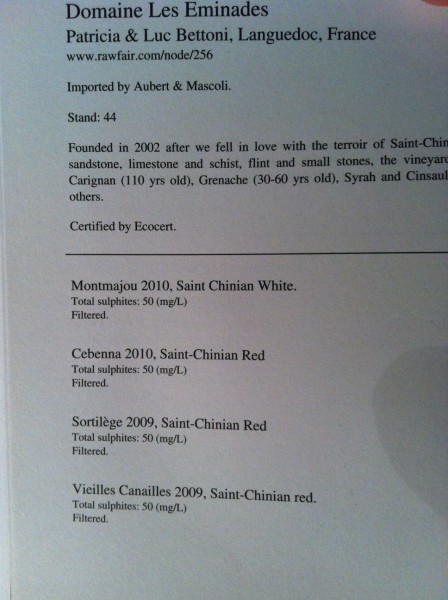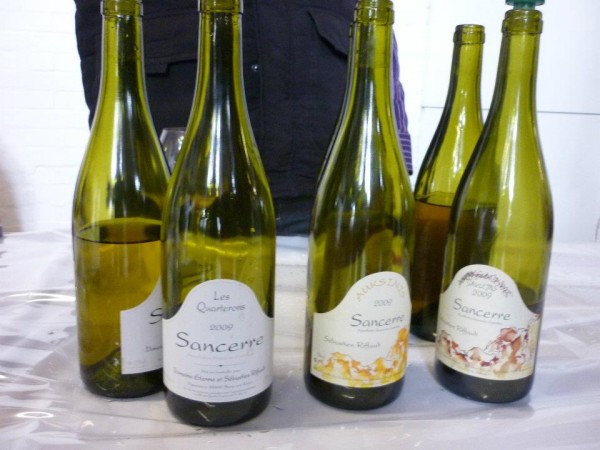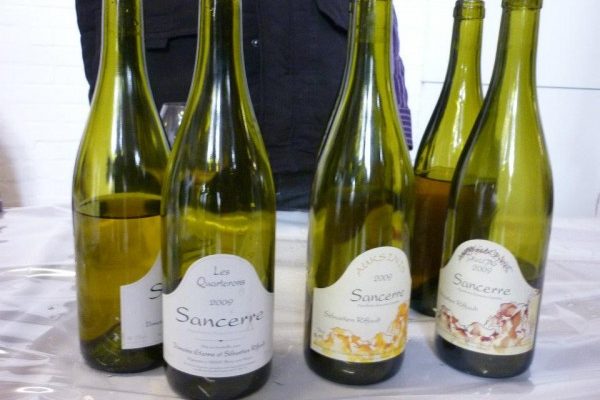What information does the consumer want from the wine he’s about to drink? Today’s labels include the alcohol percentage, sometimes a little tasting note or some generic information on the winery—and more often than not the “contains sulfites” statement. Is this really enough or does the consumer want more information? Does he want to know about all the additives and processes used in winemaking?
In the food industry, all ingredients and additives are mentioned on the label and some people have called for similar labeling laws for wine. They argue the consumer is entitled to label transparency as this may help people with certain food sensitivities (like gluten) or food practices (such as vegetarian or vegan) to make better decisions about the wines they choose to drink. Others believe that all this extra information would be overkill and confuse rather than help the consumer.
 However, label transparency seems to be gaining traction as a topic and at the RAW fair (one of two natural wine fairs held in London last week) an interesting debate was organized on the topic. The panel consisted of some pretty important and influential people in the wine world including: Isabelle Legeron MW, the founder or RAW; Clark Smith, Lecturer at U.C. Davis, Professor at CSU Fresno and Florida International University; Julia Harding MW who works with Jancis Robinson on her website’s Purple Pages; Jo Ahearne MW, wine buyer for Harrods; Guy Woodward, Editor of Decanter Magazine; Sebastien Riffault, winemaker and president of AVN (Association des Vins Naturels); The debate was chaired by Clive Barlow MW, Chair of the Education Committee of the Institute of Masters of Wine. Panel members were asked to share their opinions on label transparency before a discussion took place around questions from the audience.
However, label transparency seems to be gaining traction as a topic and at the RAW fair (one of two natural wine fairs held in London last week) an interesting debate was organized on the topic. The panel consisted of some pretty important and influential people in the wine world including: Isabelle Legeron MW, the founder or RAW; Clark Smith, Lecturer at U.C. Davis, Professor at CSU Fresno and Florida International University; Julia Harding MW who works with Jancis Robinson on her website’s Purple Pages; Jo Ahearne MW, wine buyer for Harrods; Guy Woodward, Editor of Decanter Magazine; Sebastien Riffault, winemaker and president of AVN (Association des Vins Naturels); The debate was chaired by Clive Barlow MW, Chair of the Education Committee of the Institute of Masters of Wine. Panel members were asked to share their opinions on label transparency before a discussion took place around questions from the audience.
Legeron kicked off the discussion by talking about how she would love more transparency on the labels as this, in her opinion, is the only way consumers can make clear choices about what wines they would like to drink. She led by asking winemakers involved in the RAW fair to disclose as much information as possible per wine. Indeed paging through the RAW tasting guide I saw the quantity of sulfites used for just about every wine as well as notes on fining and/or filtering.
Riffault told a similar story when he explained that as a producer and an AVN member he chooses to make wine without additives in as natural way as possible. Only a very limited use of sulfur is allowed, and the total amount of sulfites may not exceed 30mg/l for red and sparkling wines (compared to 150mg/l allowed by the EU) and 40mg/l for white wines (in stead of 200mg/l). Only when members comply with these rules are they allowed to use the AVN label on the bottle. For wines made without any added sulfur there is a special label “AVN zero added sulfites.” Riffault believes that the AVN label is a simple way to communicate better with the consumer and it allows for greater transparency.
At the other end of the scale, Smith, who is an expert in high intervention wine making, stated that in theory he has nothing against more disclosure, however this will require more work from the winemakers. He also raised the point that if all intervention were to be vilified there would be no incentive for the winemaker to disclose these practices.
Ahearne’s point of view was that there is too little space on the back label and that extra information will confuse the consumer especially if all winemaking processes and additives used in those would have to be disclosed. However stating that a wine is suitable for vegetarians could be beneficial.
 Harding preferred more transparency and disclosed some information from a poll on Jancis Robinson’s Purple Pages on this topic. Interestingly, most consumers would like to have more information, whilst the trade and winemakers prefer to disclose less. The proof is in the pudding for the latter as Europe’s main appellation organizations have petitioned to be exempt from disclosing additives used for fining (e.g., isinglass, egg whites) from 2014 onwards. Similar consumer behavior results were also disclosed by Guy, who had run a poll on Decanter.com. The poll asked if consumers would like to have more information disclosed on the label and 49% of the readers expressed a concern about chemicals and said they would like more information.
Harding preferred more transparency and disclosed some information from a poll on Jancis Robinson’s Purple Pages on this topic. Interestingly, most consumers would like to have more information, whilst the trade and winemakers prefer to disclose less. The proof is in the pudding for the latter as Europe’s main appellation organizations have petitioned to be exempt from disclosing additives used for fining (e.g., isinglass, egg whites) from 2014 onwards. Similar consumer behavior results were also disclosed by Guy, who had run a poll on Decanter.com. The poll asked if consumers would like to have more information disclosed on the label and 49% of the readers expressed a concern about chemicals and said they would like more information.
It seems there is a division in opinions between the wine trade and consumers about what information should be disclosed on the label, and how this information should be displayed. A list of additives, processes and agents used in winemaking methods would be incomprehensible to the majority of consumers, so it would be important to add context here.
Also, as the back label is not very large, some people suggested making use of technology—perhaps by printing a QR code on the label instead of a list of additives. The interested consumer would have the option to scan the code which would take him to a website with a lot more information on the winemaking process and the amounts of additives.
 Though this idea seems like a wonderful solution, there seems to be no consensus as to where these web pages should sit and who should be responsible for gathering the information and updating the pages. Some people think this information should be available on the producer’s website whilst others prefer a site which is independently managed. Both solutions, however, imply that the wine producers are the key players in the level of disclosure. But as many producers still seem reluctant to commit to this—either because of the extra work this would involve, or for fear the processes they use would put off consumers—it is unlikely that more information will be readily available in the near future.
Though this idea seems like a wonderful solution, there seems to be no consensus as to where these web pages should sit and who should be responsible for gathering the information and updating the pages. Some people think this information should be available on the producer’s website whilst others prefer a site which is independently managed. Both solutions, however, imply that the wine producers are the key players in the level of disclosure. But as many producers still seem reluctant to commit to this—either because of the extra work this would involve, or for fear the processes they use would put off consumers—it is unlikely that more information will be readily available in the near future.
Having said this, I do believe that the natural wine movement could play an important role in initiating more disclosure. It could be, as it is for AVN, a point of differentiation and a way to distinguish themselves from other wine producers. As consumers start to get a taste for this extra information they probably will demand more of it, which in turn will put pressure on other producers to disclose a little more.
The debate conclusion was that more transparency will only be achieved in the long run by pressuring producers for more information. And this pressure can either be initiated by the wine drinking community or through official regulations.
[author] [author_image timthumb=’on’]http://palatepress.com/wp-content/uploads/2012/05/caro_twitter-e1337129825708.jpg[/author_image] [author_info]Caroline is a wine educator as well as a wine marketing and social media consultant based in Champagne. She holds a WSET advanced certificate and is a certified sommelier studying for her advanced sommelier certificate. She has a particular interest in Champagne, terroir and natural wines and food and wine pairing. She blogs about all things wine related at Missinwine and Vinogusto[/author_info] [/author]

